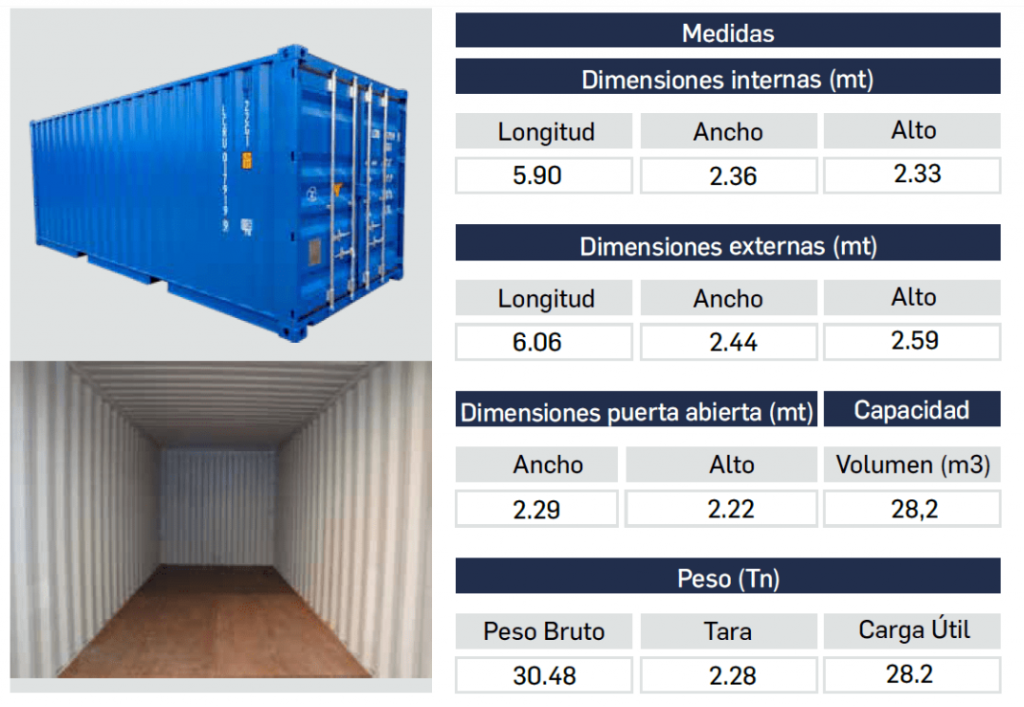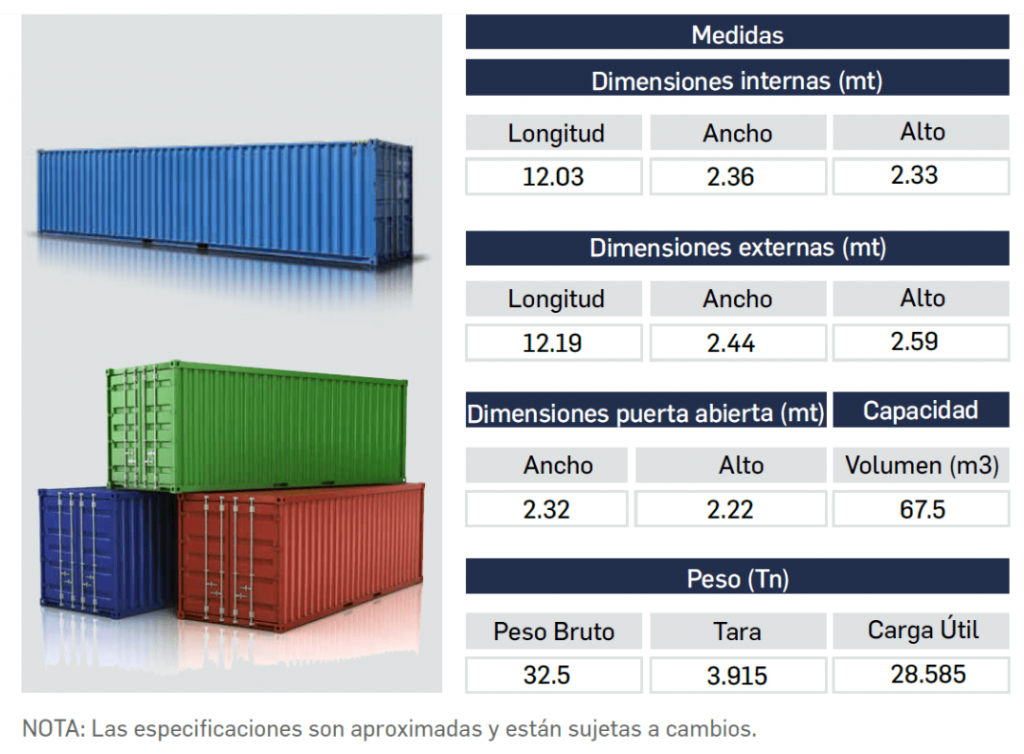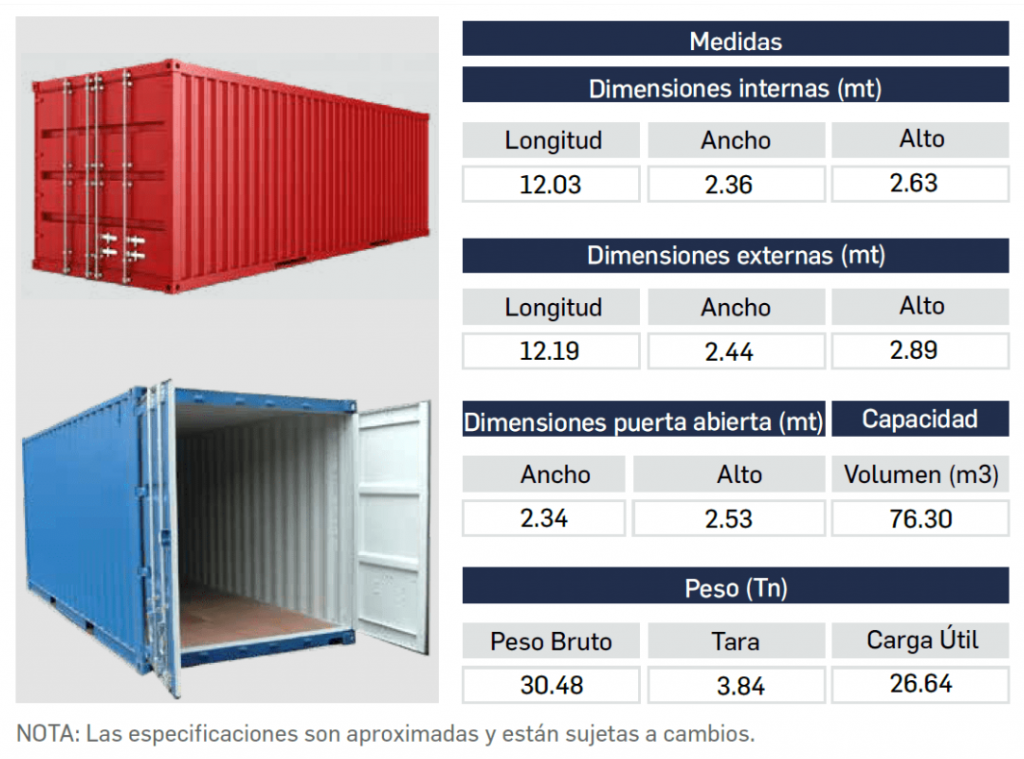There is a wide variety of container types, each fulfilling specific purposes and being suitable for one use or another. The six main categories are:



It is the type of container most used for the maritime transport of merchandise. This container can be 20 or 40 feet. The dimensions of a standard 20 foot container are approximately 20 feet (6.1 meters) long, 8 feet (2.4 meters) wide, and 8 feet 6 inches (2.6 meters) high. A standard 40 foot shipping container is similar in width and height, but is approximately 40 feet (12.2 meters) long.
The High-Cube container, also known as HQ container, is similar to a standard shipping container but has a greater height to accommodate larger or taller cargo. While a standard shipping container has a height of about 8 feet 6 inches (2.6 meters), a high cube container has a height of around 9 feet 6 inches (2.89 meters). This added height allows for additional volume and storage capacity, making it suitable for bulky or oversized loads that do not fit within the dimensions of a standard container.
A reefer container, also known as a refrigerated container, is a type of specialized container that is equipped with a refrigeration system. It is designed to transport goods that require temperature-controlled environments to maintain their quality and freshness during transit, such as fruits, vegetables, meat, fish, pharmaceuticals, and other temperature-sensitive products.
The refrigeration system within the container helps maintain the desired temperature range, typically between -25 degrees Celsius and +25 degrees Celsius, although specific temperature settings may vary based on cargo requirements.
These containers have insulation and air circulation systems to guarantee adequate temperature distribution and ventilation throughout the equipment. The refrigeration system can be powered by the container's internal power source, such as an integrated generator set, or by an external power source when the container is connected to a power outlet at a port or terminal.
Refrigerated containers have similar dimensions and structural features to standard shipping containers, typically ranging from 20 to 40 feet in length.
The use of refrigerated containers provides a reliable and efficient solution for transporting perishable goods over long distances, allowing them to reach their destination while maintaining their freshness and quality. They play a crucial role in the global supply chain for industries that rely on temperature controlled logistics.
A Flat-Rack container, also known as a platform container, is a specialized type of shipping container that is designed for the transportation of oversized or irregularly shaped cargo. Unlike standard containers with closed walls, Flat-Rack containers have open sides and ends, allowing for easy loading and unloading of cargo that does not fit within the confines of a normal container.
These containers are typically used to transport heavy machinery, industrial equipment, vehicles, construction materials, pipes, and other large and bulky items.
Flat Rack containers come in different sizes, including 20 feet and 40 feet long, and can have different weight capacities depending on their design and specifications.
An Open Top container is a specialized type of shipping container that allows for top loading and unloading of cargo. It is designed with an open top instead of a solid roof, providing easy access for loading and unloading cargo that is too large, heavy or irregularly shaped to fit through standard container doors.
These types of containers are commonly used to transport goods that exceed the height limits of standard containers, such as machinery, equipment, large vehicles, construction materials, or goods that require top loading, including bulk products such as coal or cereals. Open-Top containers are available in various sizes, the most common being 20 feet and 40 feet long. They are the same width and height as standard containers, allowing compatibility with infrastructure and transportation equipment.
A tank container, also known as an ISO tank, is a specialized type of container designed specifically for the transportation and storage of bulk liquids, gases, and powders. It consists of a cylindrical tank enclosed within a steel frame that meets ISO (International Organization for Standardization) standard dimensions for shipping containers.
These types of containers come in different sizes, including 20 feet and 40 feet long, and have standardized capacities that typically range from 20,000 to 26,000 liters, although larger and smaller sizes exist.
These containers are used to transport a wide range of products, including liquid chemicals, food-grade liquids, fuels, gases (such as Liquefied Petroleum Gas or LPG), and even powders such as cement or flour. They are commonly used in industries such as the chemical manufacturing, food and beverage, oil and gas, and agricultural sectors.
Tank containers are built to ensure safe handling and transport. They are equipped with safety features such as pressure relief valves, emergency shutoff valves, and temperature control systems. Additionally, they may have insulation or heating capabilities to maintain the desired temperature of temperature sensitive liquids.
These equipments are compatible with various means of transportation, including ships, trains, and trucks, allowing for efficient intermodal logistics.
We can help you define the appropriate type of container according to your merchandise, contact us to receive our advice.
